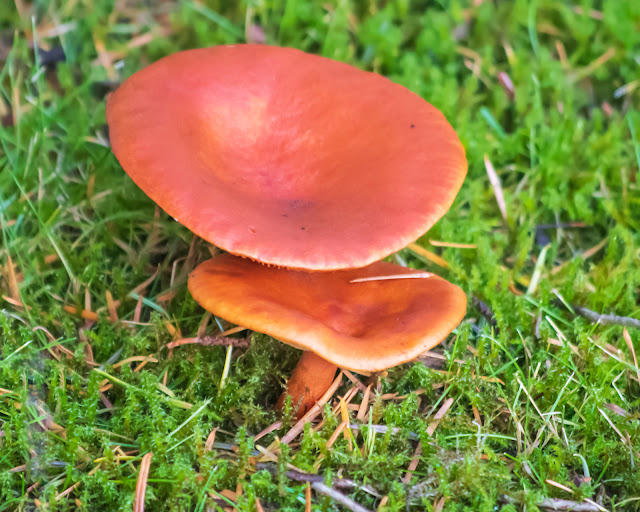Until it freezes hard, there will always be more mushrooms. These turned up in various places in the last couple of weeks.
 |
| Inside-out mushroom. |
This one grew on the museum lawn. The cap has completely inverted itself, so that from whatever direction you approach it, only the gills are visible. Searching this on Google Images, many turned up, all different species. So it's a common "behaviour", although I don't remember seeing any like this before.
 |
| Same mushroom from the opposite side. |
 |
| Small mushroom with toasty-brown leaves. Coal Creek Historic Park, Cumberland. |
 |
| I see these orange mushrooms everywhere. Both Google Images and iNaturalist suggest Lactarius sp. |
 |
| Two of the same, viewed from the top. |
 |
| A guttating polypore, on a lichen-coated tree. Comox Lake. |
I've loaded all these on iNaturalist, hoping someone can identify them.
~~~~~~~~~~~~~~~~
Mientras no se congele fuertemente el suelo, habrá más hongos. Estos los vi en varias partes en la última quincena.
- Un hongo con el sombrero volteado al revés, creciendo en el césped del museo. Desde cualquier punto de vista lo miras, solamente se ven las laminillas. Subí las fotos a Google Images, y me dieron un montón de hongos parecidos, todos de distintas especies. Parece, entonces, que es algo común, pero no recuerdo nunca haber visto similar.
- El mismo hongo, visto del lado opuesto.
- Honguito pequeño, rodeado de hojas muertas, tostadas. Visto en el Parque Histórico de Coal Creek, Cumberland.
- Encuentro estos hongos anaranjados en todas partes. Tanto Google Images como iNaturalist sugieren que puede ser Lactarius sp.
- Otros de los mismos, vistos desde arriba.
- Un políporo demostrando el proceso de gutación. En la orilla del Lago Comox.
He subido todos estos a iNaturalist, esperando que alguien me puede ayudar con la identificación.







I've never seen an inside-out mushroom before! Let us know what iNaturalist comes up with.
ReplyDeleteSo far, there have been no comments on iNaturalist, but on Facebook, in Field Naturalists of Vancouver Island,(https://www.facebook.com/groups/176587492920781/posts/1658821268030722/?__cft__[0]=AZVnoXmYzmcLMZXbD81lucwxJp-FuMqVyFcYUICZGQX37lMWfJGcNQ8sW9eMiXdXwUEzE8BXEtkUHfj6lWqVbYCpu6qf39AYatvQ8yALS7MbVrt5qrpNJIaHUb582foL68IYJsfMv3B8CmdTFaynK6LXTolSDYibDengySKwppBglwaKmSw9DcsyuYXLgcjopffhVcAKypT0ZwBz0J6ZIin4&__tn__=%2CO%2CP-R-R) they've suggested Laccaria sp. or Gomphidius sp.. One commenter mentioned, "I have seen lots of upturned Laccaria lately." I sure haven't!
Delete